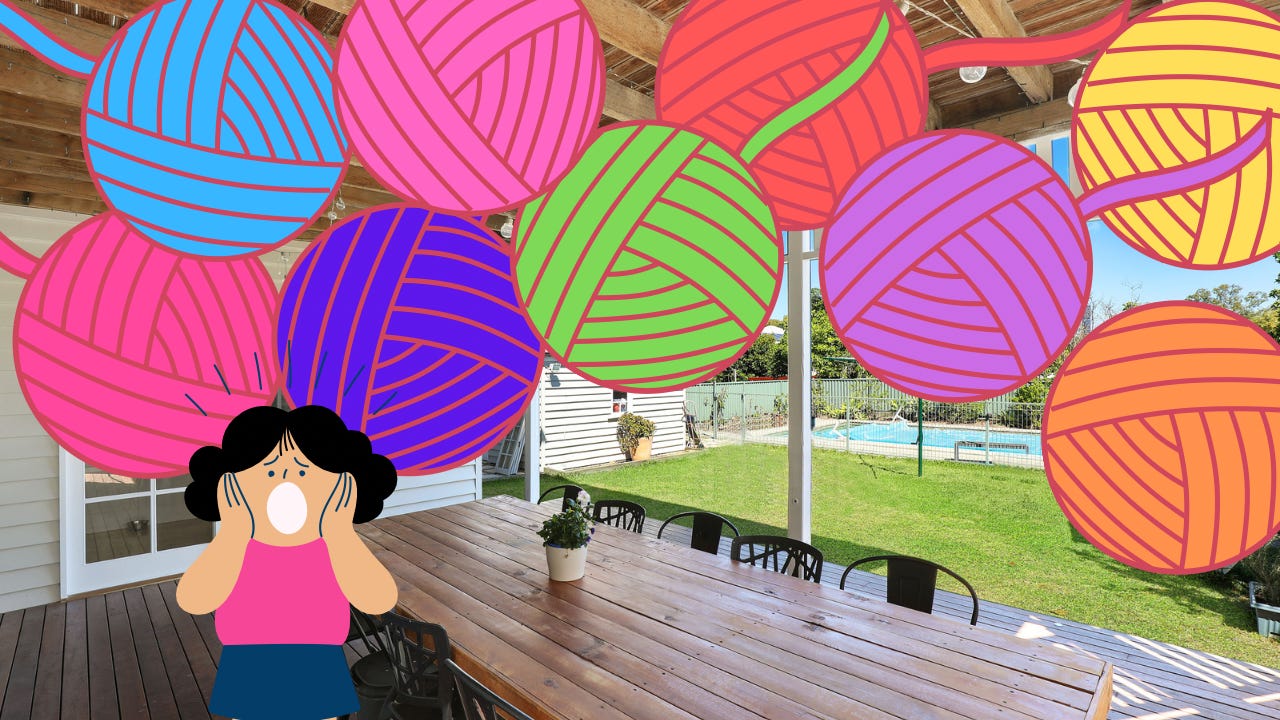Why is it that as soon as you make that large yarn purchase you’ve been debating for a while, something super expensive always crashes in through your backyard gate like the Kool-Aid Man?
That was my weekend in a nutshell.
(Don’t worry, friends. Neither the yarn purchase nor the expensive gate crasher were exceptionally dramatic. But still! Why does this happen?!)
Emergencies, well, emerge from time to time. Sometimes the “emergency”—in knitting terms—is simply an impromptu family drive to a neighboring town. You will be leaving the nest you call your knitting nook, and you will be in the car for hours! Doing nothing!!! You need your knitting!!!!!!!
Baby Steps for Knitting
I’ve shared before how Dave Ramsey’s financial “Baby Steps” helped guide my journey through casting off my suffocating pile of WIPs. To create a less stressful and more sustainable WIP situation, I followed Baby Step 2.
Step 2: Pay off all debt (except the house) using the debt snowball.
I translate this step to read: “Complete all WIPs (except very large ones like blankets) using the WIP snowball.” I won’t go into the yarny specifics of that process here, but you can read about it in my previous post:
Or watch my YouTube episode where I explain my process: Ep. 6–How I Dave Ramsey’ed my WIPs
Disclaimer: I am in no way affiliated with Dave Ramsey or his business. I just happen to respect his financial philosophy and enjoy finding my own ways of applying it to my knitting life. For further information on Dave Ramsey’s Baby Steps, check out his official website.
Today I’d like to consider Baby Step 1.
Step 1: Save $1,000 for your starter emergency fund.
I can hear the thoughts of some of you right now…. “Please, please, please, let this crazy lady start proclaiming that we should all have $1,000 worth of luxury yarns on hand—with us—at all times!”
Unfortunately, I’m not going to be quite so literal in my translation. But I’m also not going to judge your stash—mobile or otherwise! Y’all do you, and knit your own queue!
I interpret this step, with relation to my knitting practices, to mean that I should—AT ALL TIMES—have cast on an easy, on-the-go knitting project…
A Go Bag Knitting Project.
Go Bag Knitting
To qualify as “Go Bag Knitting,” the project must be housed in a project bag that will fit easily in my purse. I must also be able to slip a strap or two over my wrist in order to knit from the project bag while walking around should the need arise. (In my life, the need often arises.)
The Go Bag Knitting Project needs to be some type of “vanilla” project. For me, vanilla does not always, only, equal stockinette or garter. However, you will often find a stockinette sock on 9” circulars in my Go Bag.
Right now, I’m working on a pair of Fade Into Neverland Socks. It’s not what some may consider “vanilla,” and it’s certainly not the most basic pattern, but it’s an easy toe-up sock for me to make when I’m on the go. Even the heel is pretty straight-forward; aside from a bit of attention required on the heel turn, this heel is my absolute favorite for low-maintenance knitting.
Similarly, hats—whether stockinette or ribbed (like my Fairlea Hat)—tend to be easy to stuff in my Go Bag and knit while ranging. Scarves, cowls, and mitts can also make nice Go Bag Knitting Projects.
Occasionally I will pack a fingering weight sweater. For these, I must be more judicious regarding the “on-the-go-tasticness” of the larger projects. But sometimes, they’re great!
Whatever the type of project, for me it needs to be fairly small, relatively simple and straightforward, and require minimal referencing of the pattern and use of extra supplies.
Ok, friends, it’s your turn to tell me your favorite Go Bag Knitting Projects!!!
For some project ideas, check out my designs on…
Find more Mountain Song Designs content and inspiration on…







I love the way you apply Dave Ramsey to your knitting! And I too try to always have an easy “to go” project that I always carry with me in case of an emergency. 😉 It’s usually a sock, but I’ll soon be getting a CSM and may need to rethink my sock knitting. Hats are a good on the go project too. And I tend to make a lot of them in the fall in prep for gifts and charity.